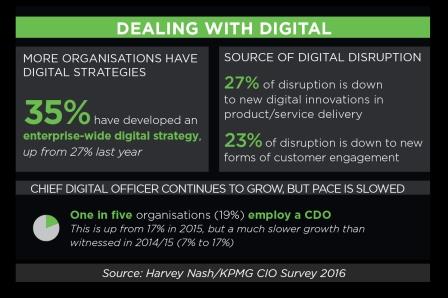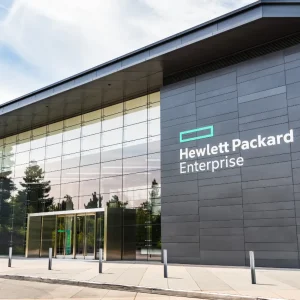
CIOs could become the next generation of CEOs as they become the trusted advisors to today’s business leaders.
Cyber security, dealing with digital transformation, delivering project success and most importantly delivering digital projects that make money, as opposed to those that save money are on the CIO’s programme.
The Harvey Nash, KPMG CIO 2016 global survey found CIOs reporting huge changes in their roles, responsibilities and priorities.
IT leaders are already seeing themselves as value drivers and more than two thirds of respondents saying their strategic influence will grow.
Among the new core priorities reported are:
- Outperforming competition with new business models (23%)
- Better engagement with customers/prospects (38%)
- Developing innovative new products and services (41%).
The survey report, (The Harvey Nash/KPMG CIO Survey 2016-The Creative CIO) says these priorities represent a ‘long tail’ of new priorities
In addition CIOs are reporting continued expectations to prioritise increased operational efficiency (57% named as a core priority), improved business process (56%) and saving costs (50%).
CBR spoke with Adam Woodhouse of director at KPMG CIO Advisory on the findings of the survey, see below for coverage.
Make money with projects
This shift is further reflected in the finding that 63% of CIOs are reporting that CEOs are more likely to be interested in projects that ‘make money’ for the business with 37% saying CEOs would advocate projects that save money.
The CIO is more likely to report to the CEO than in any time in the past. Thirty four per cent report directly to the CEO, a leap of 10% over last year.
One area of challenge for CIOs is in their relationship with senior stakeholders in other departments beyond the traditional close relationships with finance and operations.
In 2016 those CIOs who classed themselves as having ‘very strong’ relationships with other departments were:
- HR (33%)
- Legal/compliance (35%)
- Marketing (32%)
- Sales (36%)
- Finance (49%)
- Operations (61%).
Project Success
On the topic of project success, CIOs reported greater levels of success in new types of technology roll outs. Rates of reported successful project outcomes in the last two years included:
- New website/CMS (65%)
- New mobile apps (57%)
- Moving systems to the cloud (66%).
This compares with more traditional project type success reported success rates of:
- ERP roll out (44%)
- New finance system (46%)
- Big data implementation (43%).
The highest success rate for projects reported in 2016 was Infrastructure Roll-Out (70%).
Dealing with digital
For the second year in a row data analysis and digital skills were ranked as most in demand with 39% reporting this as their main requirement.
In its Dealing with Digital section the Harvey Nash/KPMG report split the industry into three groups.
These were those with IT budgets of below $100 million, those with IT budgets of between $100 million and $250 million and those IT budgets in excess of $250 million.
The survey found those with It budgets in excess of $250 million are more likely to have implemented an enterprise-wide digital strategy (43%) compared to the middle tier of $100 million and $250 million where one third said they had done so.
When broken down by sector it was found that enterprise wide digital strategies were found (in descending order) in: Advertising (52%); Broadcast/Media (49%); Technology (48%); Government (40%); And financial services (37%).
Bringing up the rear were: Education, (18%); Manufacturing (20%); And Construction/engineering (22%).
Ownership of Digital
Who has taken ownership of the digital strategy within the organisation revealed some interesting views from the CIOs questioned.
The survey found digital was reportedly owned by the following:
- C-Suite & Board of directors (37%)
- IT/Technology (16%)
- Combination of IT and marketing (14%).
No-one formally owning the digital strategy reported by 11% of respondents.
2016 is the second year that KPMG worked with Harvey Nash on the survey. KPMG contributed around 20 questions to the survey. This year was also the first time that saw MIT contribute to the survey.
CBR spoke with Adam Woodhouse, Director at KPMG CIO Advisory. He said as digital becomes more embedded and mature business users are more and more becoming technologists in their own right and this is changing the relationships with the IT folks of old. As we move towards new digital business models the responses to the ownership question in the survey clarifies what is happening at a CEO and board level.
"The CIO shouldn’t’ and can’t control all technology spend. Fifty per cent or greater will be outside their control. So they must become an enabler, they must step outside traditional strong relationships with ops and finance and get on an equal footing with all people on the board. This includes HR, ops and the risk officer and they must become a technology enabler for these stakeholders. CIOs need to become a tech and digital strategist and evangelist and a transformational business leader. They must be able to say to the different board members and business owners ‘this tech is proven, it works for your business.’"
With two thirds of respondents saying they are being asked to deliver projects to make money and just to save money the CIO must demonstrate how and when they are effective with use of capital. This will open up the future wave of projects.
The challenges come from proving IT’s value with successful project outcomes. As noted above traditional IT project success rates are static, but ‘new’ tech project success is growing.
Mr Woodhouse says: "This is a little concerning. If in traditional projects IT is reporting a lack of success, say, where one in five projects is failing then it is too many unsuccessful things."
"Take agile and new methodologies, it might require a step back. Can you deploy agile if one in five of your projects is failing? The new wave of agile development methodologies is about addressing culturally inflexible ways of doing things in order to fail fast. And I don’t think CIOs need to see failure rates going up."
As for IT owning the digital strategy does the survey show good news for CIOs?
Mr Woodhouse says, can they own it? Yes. Can they own it successfully? Yes.
"It is better for the CIO. The digital strategy is bigger than one person. It is an enterprise wide business strategy and it is an IT strategy. This is the future of the business."
"The CIO must be a transformational business leader, and a business model innovator. CEOs are looking at the CIO as most tech savvy resource and the question for CIOs is can they take a leading role in driving the digital strategy forward so they are really seen as a peer."
Overall – does the survey indicate CIO role is a good job to have?
"The survey is good news for the CIO," says Mr Woodhouse. "There is a high degree of job satisfaction reported. And CIO leaders will increasingly see the opportunity to move into the CEO role. Look at digital transformation and disruption as expanding the core and creative CIOs are looking for adjacent opportunities. Organisations are asking, what’s the core of business in the context of the all the disruptive new things around."
What does it say about what it takes to be a successful CIO 2016-18?
"There is massive opportunity. The CIO must grab the opportunity to get to the board and inform a conscious digital strategy and how to deal with it."
"At one end of the spectrum a company might take the view that ‘We want to be a lead innovator on everything.’ Or a company may decide to be a fast follower, to be less aggressive on the innovation front and spotting what’s next. For the CIO it is about disruption and innovation and knowing what is the agile architecture of the future and what to build around that."






